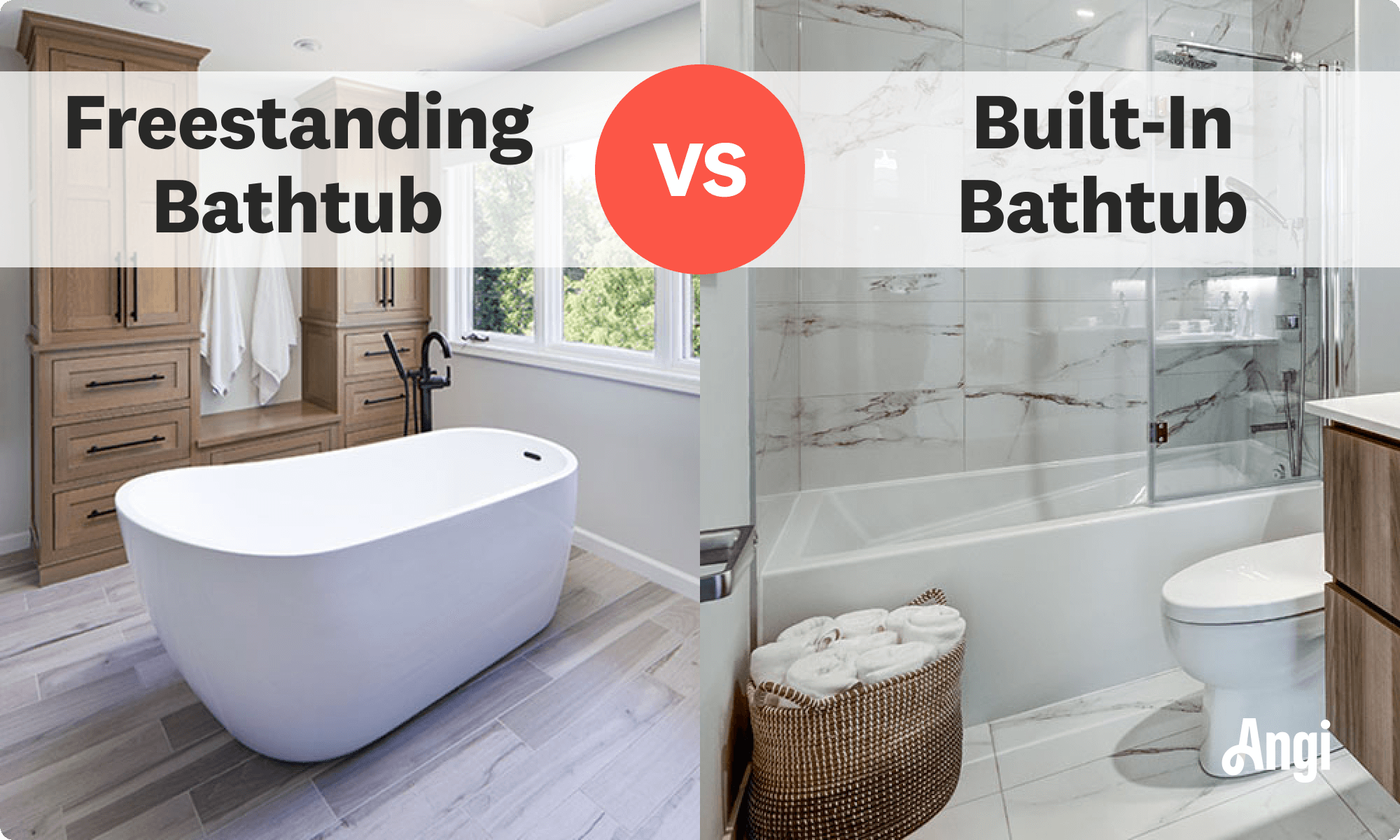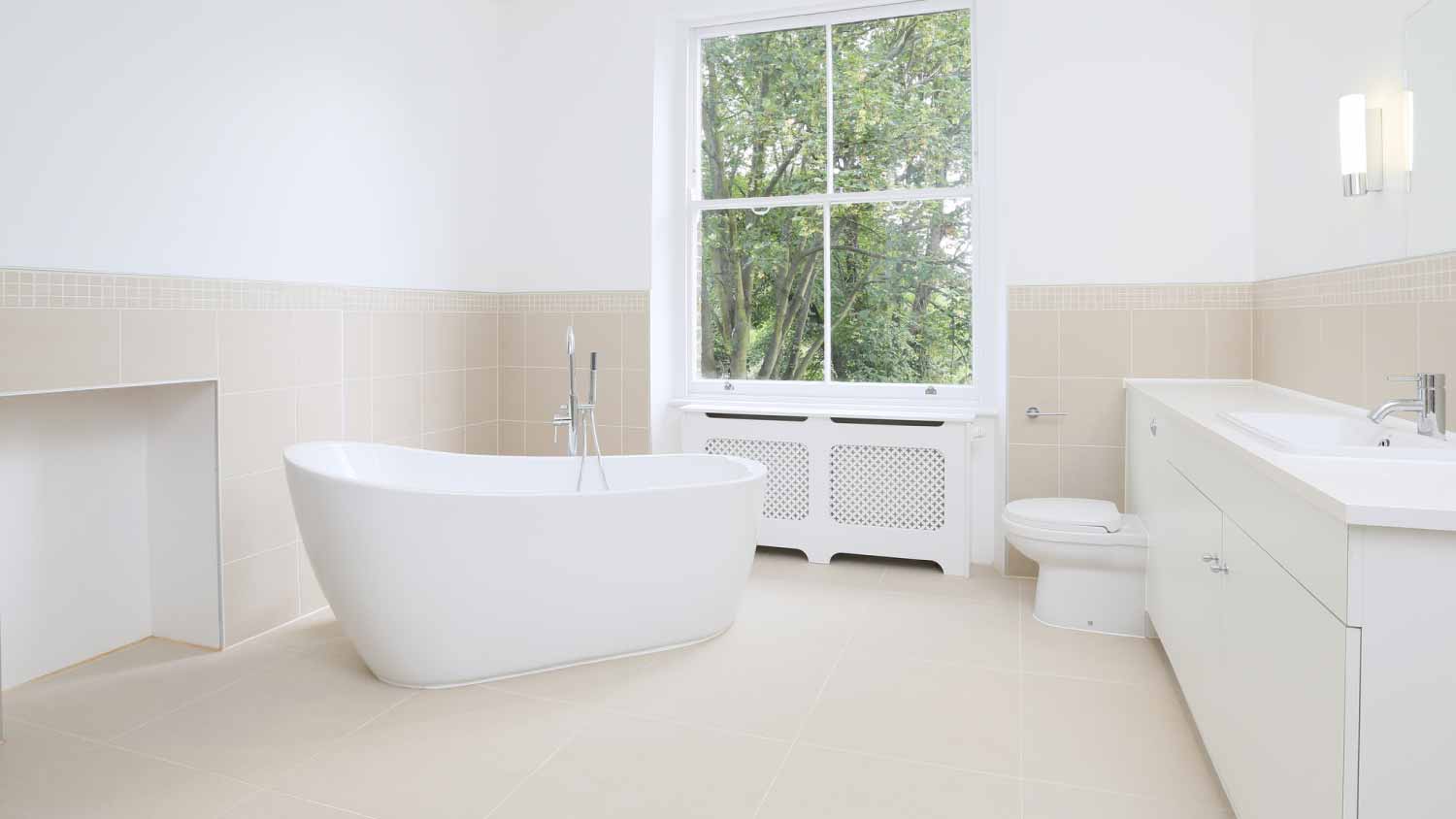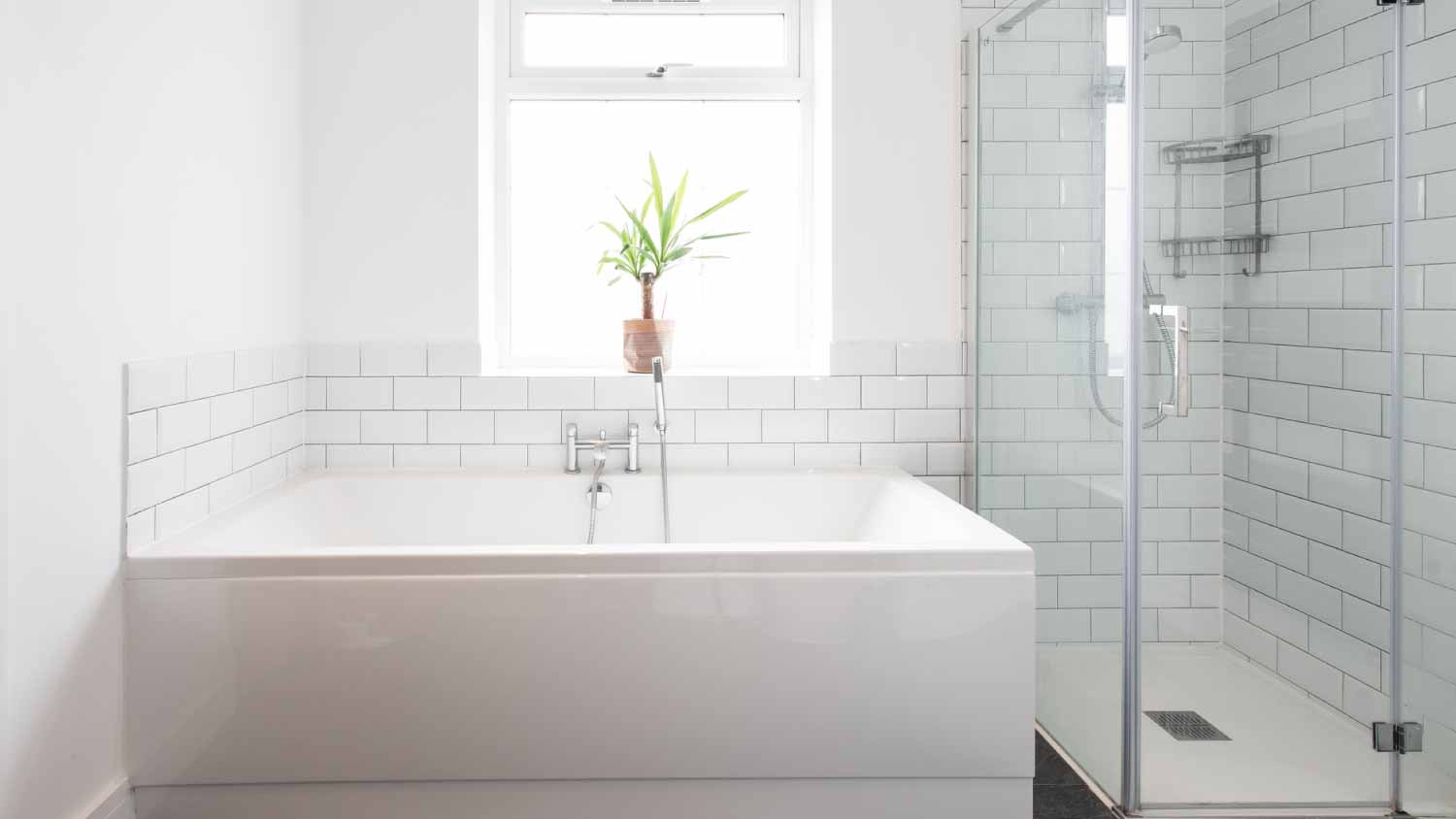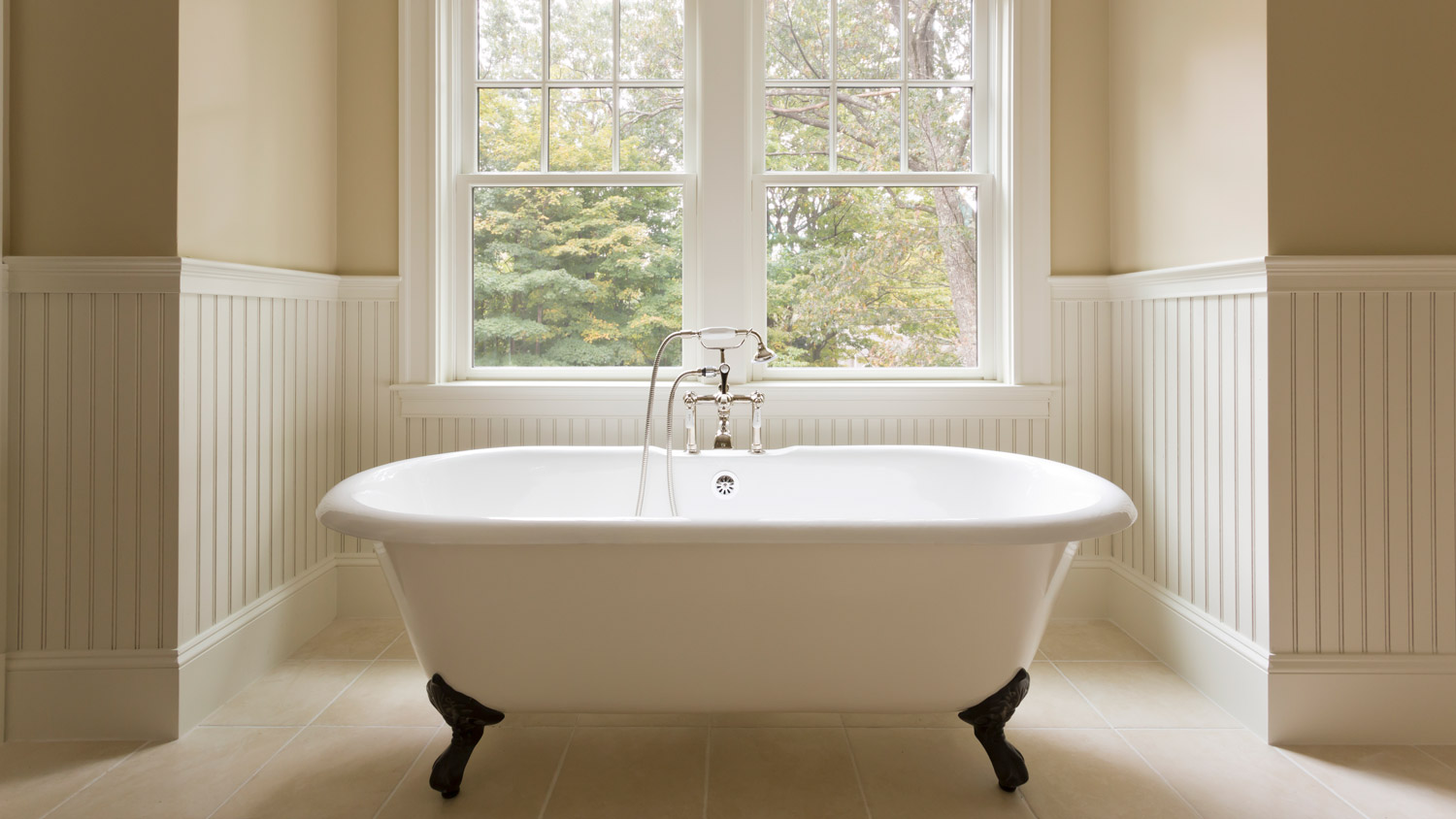
Shower pan replacement costs $530 to $2,700. Find out how material, shower size, labor, and more affect the final project budget.
Dip your toe into the world of bathtubs


Freestanding bathtubs can be installed almost anywhere for a luxurious spa-like soak.
Built-in bathtubs are more common and found in most bathrooms.
Key differences include the price, ease of installation, and appearance.
Freestanding bathtubs cost between $2,000 and $9,000, while a built-in tub costs $200 and $1,000.
Installing a new bathtub in your home comes with a surprising number of choices, including deciding between a freestanding bathtub versus a built-in bathtub. Both have advantages, but each type of tub has a few drawbacks to consider before jumping in. Here’s how freestanding and built-in tubs stack up against each other.

If you need a relaxing soak, freestanding and built-in bathtubs can both do the job, but there are key differences to consider before choosing the right one for your bathroom. Freestanding bathtubs are separate from any surrounding support structure in the bathroom, while built-in tubs are installed alongside walls or in a custom-built surround.
Freestanding bathtubs are deeper than built-in tubs, offering a more luxurious bathing experience. They’re also available in various materials, including natural stone and copper, whereas most built-in bathtubs are available in acrylic, fiberglass, or enameled steel. A bathtub installer can recommend the best type of bathtub and materials for your bathroom.

A freestanding bathtub is a stand-alone tub that doesn’t include a shower and can be placed anywhere in the bathroom with adequate plumbing and floor support. They’re available in a range of materials, including fiberglass and acrylic, but you can also find them in natural stone, cast iron, solid surface, and copper.
| Pros | Cons |
|---|---|
| Modern and luxurious | More expensive than built-in versions |
| Variety of materials and shapes | Doesn’t come with a shower |
| You can convert it into a shower | Requires a dedicated space |
Best for:
Budgets with room for a specialized installation
Larger bathrooms with enough space
Unique bathroom designs that would benefit from a one-of-a-kind tub
Freestanding bathtubs are popular with those who want a spa-like experience in their homes. They come in a wide variety of shapes and materials that allow for more customization than a built-in bathtub. These tubs serve as a focal point in beautiful design statements and serve a functional purpose.
Freestanding bathtubs are more expensive than standard built-in bathtubs. While they’re a beautiful focal point, they don’t have a wide ledge for storage or support like a built-in tub. They also don’t include a shower, meaning you’ll need to install a separate shower or add a shower conversion kit to the freestanding tub.
This bathtub style works better in larger bathrooms, but with the right configuration, they can also work in smaller bathrooms, especially if the room doesn’t include a shower. Installation is more challenging for freestanding versus built-in tubs because you’ll need to reroute the plumbing through the floor and potentially the wall, depending on where the fixtures are located. This can add additional expenses to your bathtub replacement costs.

A built-in bathtub comes standard in most homes and is either surrounded by walls on three sides or set into a dedicated structure. Built-in bathtubs commonly include a shower, offering versatility in a space-saving design.
| Pros | Cons |
|---|---|
| Budget-friendly option | Fewer customization options |
| Lower profile for easy entry | Requires sealing to prevent water leaks |
| Standard in most homes | Lacks a unique design |
Best for:
Replacing an existing built-in bathtub
Smaller remodeling budgets
More accessibility for older adults and children
Built-in bathtubs are the standard in many homes and can be either an alcove style or a drop-in tub. Some of these tubs include a shower for versatility and come in a variety of materials, including acrylic, fiberglass, or enameled steel. Acrylic or fiberglass built-in tubs are lightweight, making installation easier, particularly with the help of a bathtub installation pro near you.
Consider acrylic instead of tile for your next bathroom project. Acrylic is less expensive, easier to maintain, more durable, and less time-consuming to install.
Installing or replacing a built-in bathtub requires measuring correctly to ensure the tub will fit into the bathroom’s design. Built-in tubs must also be sealed around the edges to protect the surrounding areas from water damage. This style of tub does offer some customization options, but it doesn’t match the range of materials and styles available for freestanding tubs.
Freestanding bathtubs and built-in bathtubs both achieve the goal of providing a place to bathe but offer different advantages. In some categories, one pulls ahead of the other.
In terms of appearance, freestanding tubs offer a unique style that adds a touch of luxury to a bathroom. They come in various styles and act as a centerpiece for a bathroom. A built-in tub can be styled to enhance the look of a bathroom, but it doesn’t bring the character and one-of-a-kind style that a freestanding tub does.
Freestanding bathtubs come in a variety of common bathtub materials like fiberglass and acrylic, but you can also choose between natural stone, marble, cast iron, and solid surface. Some models offer a sleek and modern appearance, and others bring a bit of nostalgia with claw-foot versions.
While built-in bathtubs mostly come in rectangular or oval shapes, their appearance doesn’t vary as much. For freestanding tubs, however, homeowners can choose between different shapes because the tubs aren’t enclosed by a structure or surround. Designers are free to create curved edges or irregularly shaped tubs that fit homeowners’ unique design needs.
If you want a freestanding tub and a shower, you can get the best of both worlds by installing a shower conversion kit on your freestanding tub and hanging a shower curtain around the entire tub.
Built-in bathtubs are more affordable than freestanding tubs, with standard tubs costing between $200 and $1,000, depending on factors like size, material, faucets, labor for installation, plumbing work, and subfloor preparation. Highly customized freestanding tubs—or those made from natural stone, copper, or wood—start at around $2,000 and go up to $9,000 or more.
Since many homes already have a built-in bathtub, it’s relatively easy to replace the existing tub to keep installation costs low, but you might need to build a surround if you’re installing a new drop-in tub. You’ll also need to seal the tub properly to prevent water leaks.
Freestanding tubs are stand-alone units that don't meet a wall, ledge, or other area that would need to be sealed. However, installation is more complicated if you need to reroute the plumbing, in which case you need to hire a licensed plumber who installs bathtubs. If you already have a freestanding tub, purchasing a new one that fits the existing plumbing will make the installation easier.
From average costs to expert advice, get all the answers you need to get your job done.

Shower pan replacement costs $530 to $2,700. Find out how material, shower size, labor, and more affect the final project budget.

The cost to add a bedroom and bathroom can pay off with an increase in your home’s value and more space for you and your family. Costs vary by project scope.

Remodeling your bathroom can add significant value to your home. Your bathroom remodel cost in Columbus, OH will depend on size, fixtures, materials, labor, and other factors.

An updated bathtub can give a bathroom a whole new look. Find out how much it costs to replace a bathtub in San Francisco, CA, including prices by type and labor costs.

Working from home is only productive if you have a dedicated office space. Learn the cost to build a home office, from materials to labor rates.

Learn everything about brushed nickel versus stainless steel faucets so you can choose between the two for your next remodeling project.